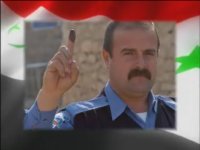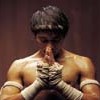Agam's Gecko


Friday, October 26, 2007
SUU KYI MEETS WITH JUNTA; REFUGEES TELL OF THEIR ESCAPE
| F |
or the second time since mass demonstrations broke out in Burma last month and the violent crackdown which ended them, Burmese opposition leader Aung San Suu Kyi has been seen on the state-controlled media. According to Myanmar State Television, she was driven from her home (where she is held under detention) to a government guest house at 2 pm on Thursday, where she met for the first time with newly appointed "Minister for Relations" retired Maj. Gen. Aung Kyi until 3:15 pm. No details of the discussions were released.
At the same time, army troops were out in force around Rangoon yesterday as pilgrims thronged to Shwedagon and other pagodas to mark the end of the Buddhist Lent period. The day also marked one month since the violent crackdown against monks and citizens demanding democracy for their country. The soldiers were fully armed with assault rifles and tear gas, with plenty of barbed wire on hand to blockade whatever they felt necessary. The authorities remain very jumpy about picture-taking.
A Myanmar [Burmese] reporter who tried to take a photo of the pilgrims climbing up the eastern gate of the Shwedagon was immediately surrounded by nearly a dozen riot police and a police officer confiscated the flash card from the camera.One of the monks' organisations leaders has reached the relative safety of Mae Sot, a Thai border town across the Moei River from Burma, where he was interviewed by western media, including the New York Times. Ashin Kovida says that he had some inspiration in deciding to take to the streets.
He said he was inspired by the popular uprisings in Yugoslavia against the government of Slobodan Milosevic, videos of which were circulated by dissident groups in Myanmar.The young monk told the Washington Post's Jill Drew that the protests had been planned to last for nine days beginning September 18, and that they were determined to keep them peaceful.
Eight members of his organizing committee are “missing” and six others are hiding in Yangon, he said. He described escaping to Thailand by using a false identification card, dyeing his hair blond and wearing a crucifix.
Another new refugee in Mae Sot, U Pan Cha is a businessman who participated in the 1988 uprising and managed security for last month's demonstrations. He said he had been holding regular meetings with government officials to outline the next day's program and to guarantee security. There had been no attempt to stop the protests at that point, only to ensure they remained peaceful. He also confirmed several things reported in the Burmese exile media (and relayed here) when the crackdown began.
Pan Cha said that on the second day of the protests, he saw soldiers clapping as the procession passed their post. He said he learned that night that Senior Gen. Than Shwe, head of the junta, had issued an order to shoot the protesters but that the local official said he would not follow the order. On Sept. 26, Pan Cha said, he received word that a different army unit, from the 66th Division, which for years had battled ethnic minority rebels from Karen state, had been brought to Rangoon. That day, the violence began.There is support within the military for democratic reform. Officers did refuse Than Shwe's order to murder. And army troops fresh from the genocidal war against the Karen in eastern Burma were then sent in to do the dirty work.
Pan Cha also filled in some details of the dramatic meeting with Aung San Suu Kyi outside her home on the 22nd. He had outlined the plan to march past her house in his regular meeting the previous night with the government official.
When the marchers arrived at University Avenue, where the Nobel Peace laureate's house is located, an army captain let them pass after conferring on the phone and with other officers and police on the scene.This was the first display of a political aspect to the monks' demonstrations. The following day, a request was made by the All Burma Federation of Student Unions, a banned group, to display their fighting peacock flag -- a symbol of the student movement of 1988. Pan Cha discussed this with the monks' leaders who decided to allow the students, as well as members of the National League for Democracy to carry their banners on the 24th. Over the next two days, the demonstrations remained peaceful.
"I was so happy I cried," Pan Cha said, his voice rising as he recalled the moment. "All the world leaders who want to meet with her and are not allowed, but we are allowed to meet. We could make the world know the Burmese people showed unity in support of Suu Kyi."
When U Pan Cha went for his regular meeting with the official on the night of the 25th, the official didn't show up. The next day the violence began.
The expected flood of refugees has not materialized in Mae Sot, where the UN resettlement office reports only 52 applications for refugee status from those fleeing the crackdown. National League for Democracy foreign affairs committee chairman Nyo Ohn Myint told the New York Sun, "People are sticking inside because they have hope."
One recent arrival from Rangoon, Ye Htun Kyaw, said the trickle of refugees meant many activists were choosing to stay put and organize the next round of demonstrations.However as the Sun notes, the lack of refugees may also be a testament to the regime's ruthless efficiency.
"They realize the importance of the inside movement, so they decided to stay in Rangoon," Ye Htun Kyaw, who was released from prison in 2005 after serving part of a 21-year sentence for organizing a student demonstration in 1998, said.
The Sun's story also offers an interesting account of two friends, both former political prisoners, who arrived in Mae Sot 24 hours after leaving Rangoon on October 3. The pair had to take many precautions to avoid capture, passing through more than three dozen government checkpoints and cleverly taking three buses to get near the border -- getting off each before the ticketed destination to avoid government agents who might be waiting for them. Now in the relative safety of Thailand, they must remain in hiding due to having no legal status here.
There are rumours of an imminent crackdown against Burmese exile groups in Thailand, and reports that at least one Burmese exile media outlet has been directed to close its operation.
Labels: Burma











 Our way of saying "thanks" in the Thai way. Here a nak muay Thai (kickboxer) offers respect and thanks for his teacher (wai khru) before a match. This is our local variation on the ubiquitous "hat tip" used in general blog culture.
Our way of saying "thanks" in the Thai way. Here a nak muay Thai (kickboxer) offers respect and thanks for his teacher (wai khru) before a match. This is our local variation on the ubiquitous "hat tip" used in general blog culture.





